Lexus GS250 2012 Owner's Manual
Manufacturer: LEXUS, Model Year: 2012, Model line: GS250, Model: Lexus GS250 2012Pages: 914, PDF Size: 53.04 MB
Page 681 of 914
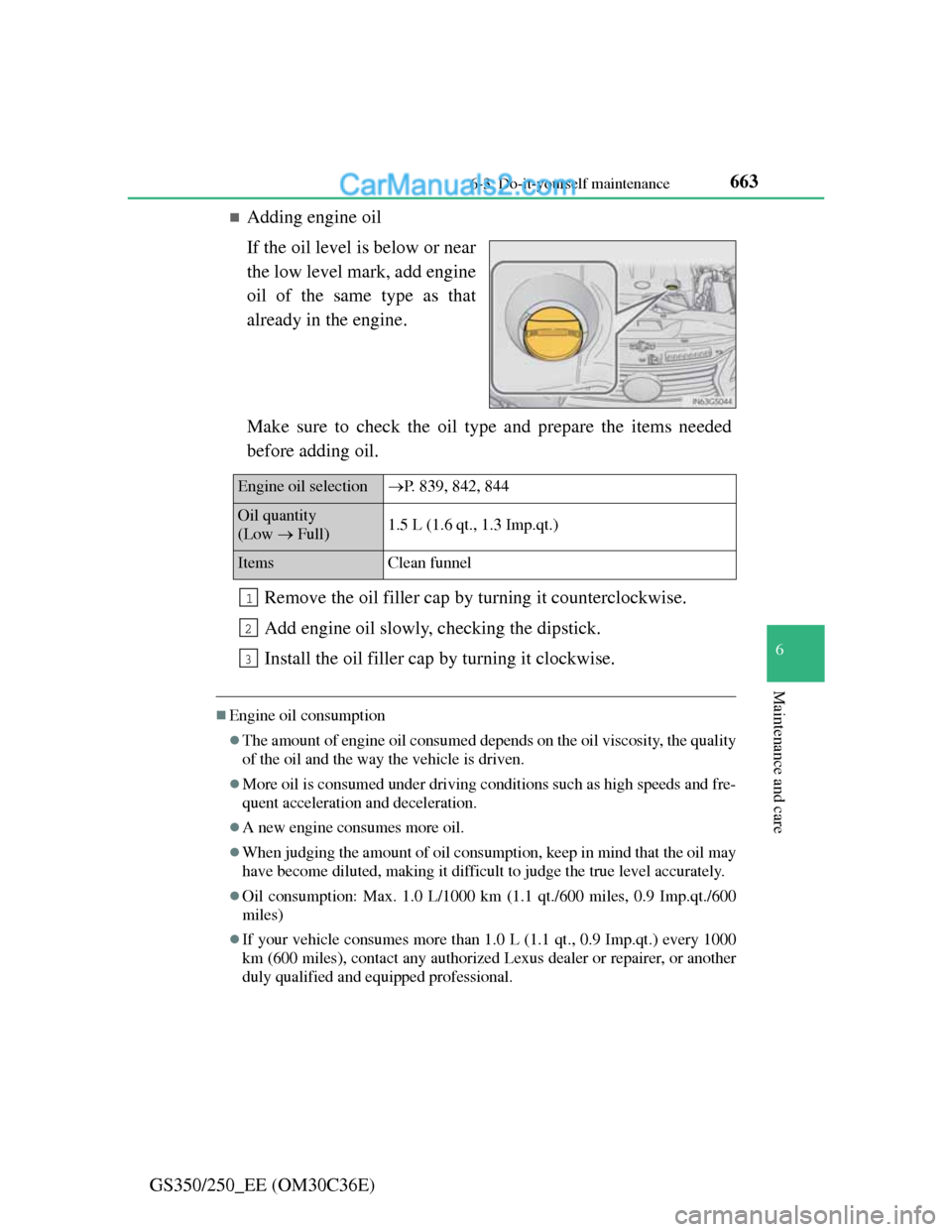
663 6-3. Do-it-yourself maintenance
6
Maintenance and care
GS350/250_EE (OM30C36E)
Adding engine oil
If the oil level is below or near
the low level mark, add engine
oil of the same type as that
already in the engine.
Make sure to check the oil type and prepare the items needed
before adding oil.
Remove the oil filler cap by turning it counterclockwise.
Add engine oil slowly, checking the dipstick.
Install the oil filler cap by turning it clockwise.
Engine oil consumption
The amount of engine oil consumed depends on the oil viscosity, the quality
of the oil and the way the vehicle is driven.
More oil is consumed under driving conditions such as high speeds and fre-
quent acceleration and deceleration.
A new engine consumes more oil.
When judging the amount of oil consumption, keep in mind that the oil may
have become diluted, making it difficult to judge the true level accurately.
Oil consumption: Max. 1.0 L/1000 km (1.1 qt./600 miles, 0.9 Imp.qt./600
miles)
If your vehicle consumes more than 1.0 L (1.1 qt., 0.9 Imp.qt.) every 1000
km (600 miles), contact any authorized Lexus dealer or repairer, or another
duly qualified and equipped professional.
Engine oil selectionP. 839, 842, 844
Oil quantity
(Low Full)1.5 L (1.6 qt., 1.3 Imp.qt.)
Items Clean funnel
1
2
3
Page 682 of 914

6646-3. Do-it-yourself maintenance
GS350/250_EE (OM30C36E)
CAUTION
Used engine oil
Used engine oil contains potentially harmful contaminants which may
cause skin disorders such as inflammation and skin cancer, so care should
be taken to avoid prolonged and repeated contact. To remove used engine
oil from your skin, wash thoroughly with soap and water.
Dispose of used oil and filters only in a safe and acceptable manner. Do
not dispose of used oil and filters in household trash, in sewers or onto the
ground.
Call any authorized Lexus dealer or repairer, or another duly qualified and
equipped professional, service station or auto parts store for information
concerning recycling or disposal.
Do not leave used engine oil within the reach of children.
NOTICE
To prevent serious engine damage
Check the oil level on a regular basis.
When replacing the engine oil
Be careful not to spill engine oil on the vehicle components.
Avoid overfilling, or the engine could be damaged.
Check the oil level on the dipstick every time you refill the vehicle.
Be sure the engine oil filler cap is properly tightened.
Page 683 of 914
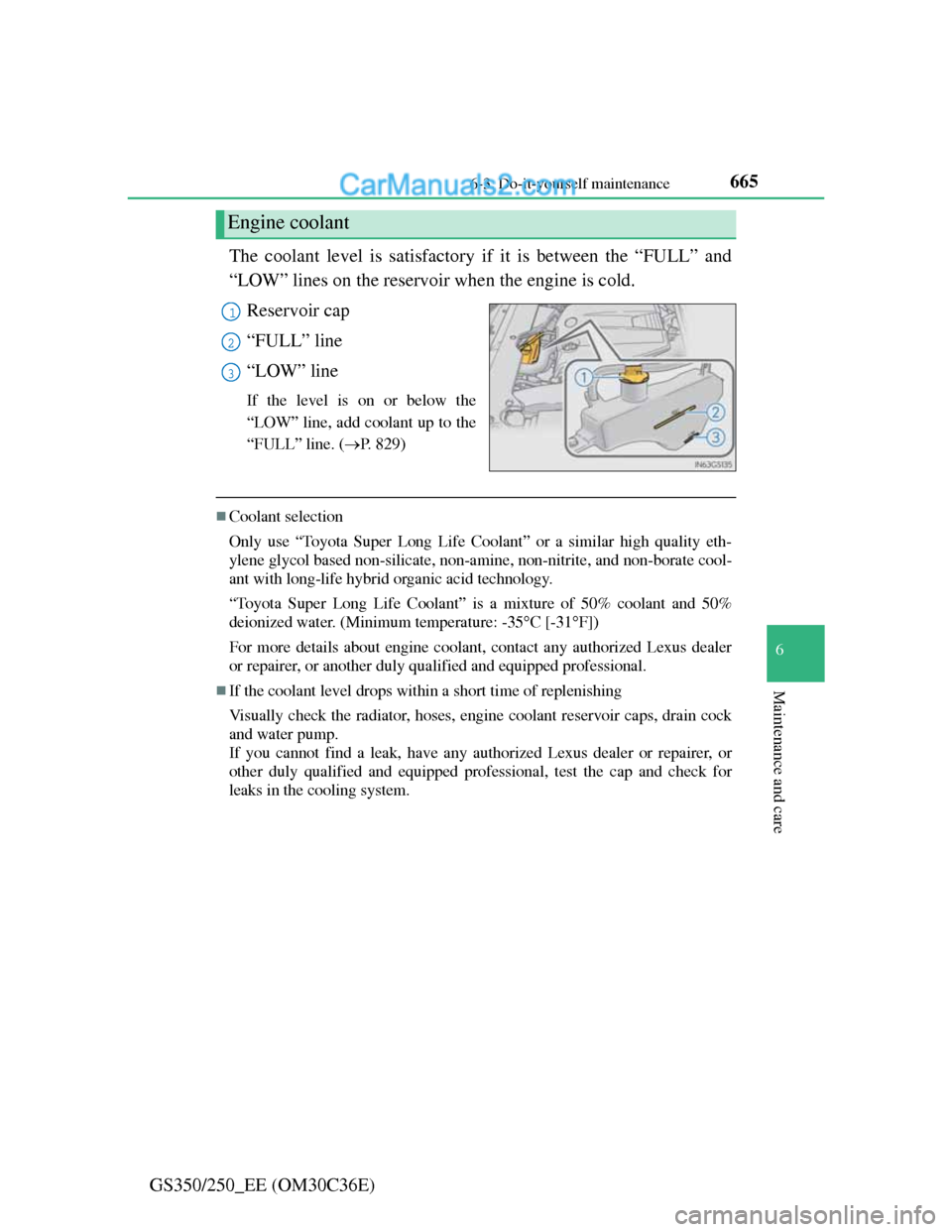
665 6-3. Do-it-yourself maintenance
6
Maintenance and care
GS350/250_EE (OM30C36E)The coolant level is satisfactory if it is between the “FULL” and
“LOW” lines on the reservoir when the engine is cold.
Reservoir cap
“FULL” line
“LOW” line
If the level is on or below the
“LOW” line, add coolant up to the
“FULL” line. (P. 829)
Coolant selection
Only use “Toyota Super Long Life Coolant” or a similar high quality eth-
ylene glycol based non-silicate, non-amine, non-nitrite, and non-borate cool-
ant with long-life hybrid organic acid technology.
“Toyota Super Long Life Coolant” is a mixture of 50% coolant and 50%
deionized water. (Minimum temperature: -35C [-31F])
For more details about engine coolant, contact any authorized Lexus dealer
or repairer, or another duly qualified and equipped professional.
If the coolant level drops within a short time of replenishing
Visually check the radiator, hoses, engine coolant reservoir caps, drain cock
and water pump.
If you cannot find a leak, have any authorized Lexus dealer or repairer, or
other duly qualified and equipped professional, test the cap and check for
leaks in the cooling system.
Engine coolant
1
2
3
Page 684 of 914
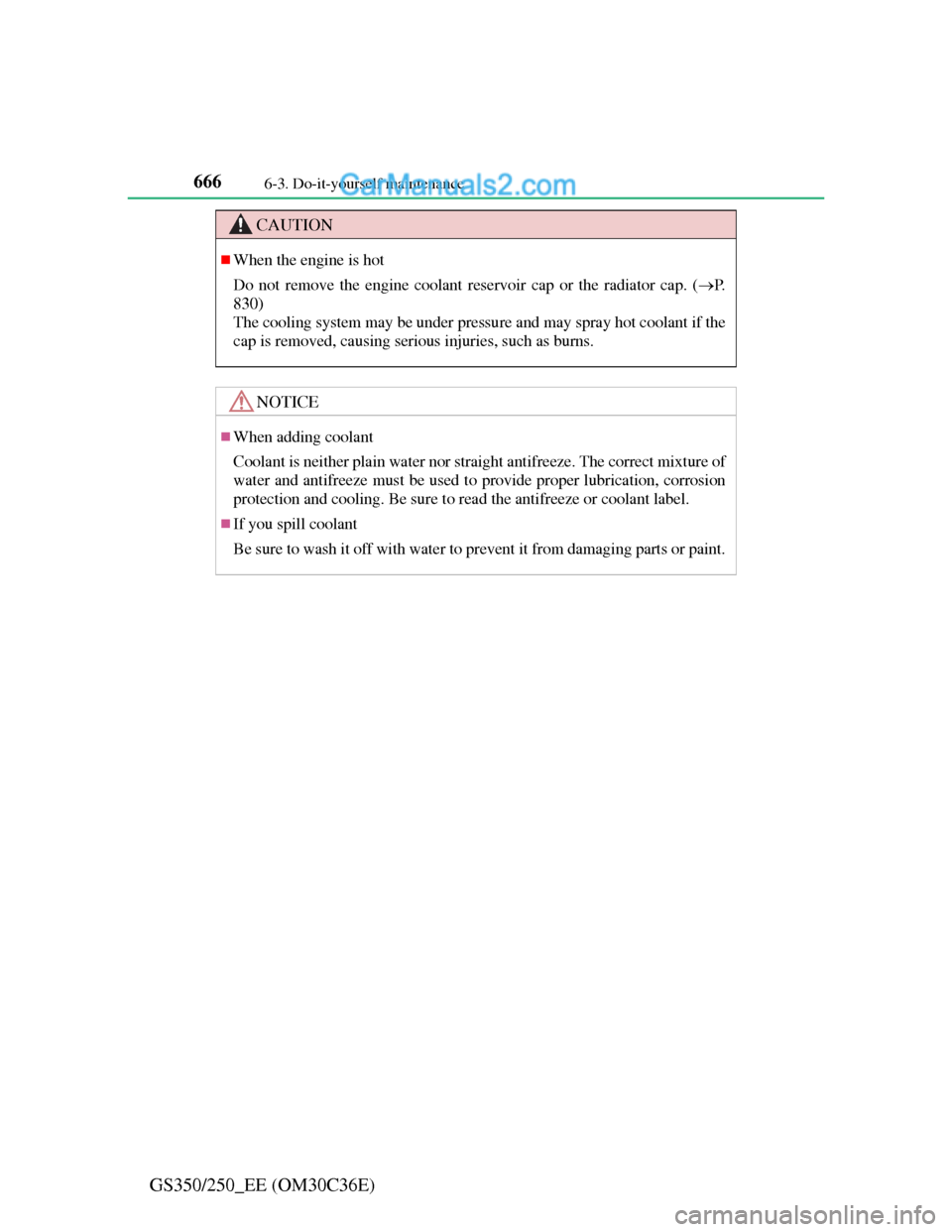
6666-3. Do-it-yourself maintenance
GS350/250_EE (OM30C36E)
CAUTION
When the engine is hot
Do not remove the engine coolant reservoir cap or the radiator cap. (P.
830)
The cooling system may be under pressure and may spray hot coolant if the
cap is removed, causing serious injuries, such as burns.
NOTICE
When adding coolant
Coolant is neither plain water nor straight antifreeze. The correct mixture of
water and antifreeze must be used to provide proper lubrication, corrosion
protection and cooling. Be sure to read the antifreeze or coolant label.
If you spill coolant
Be sure to wash it off with water to prevent it from damaging parts or paint.
Page 685 of 914

667 6-3. Do-it-yourself maintenance
6
Maintenance and care
GS350/250_EE (OM30C36E)Check the radiator and condenser and clear away any foreign
objects.
If either of the above parts is extremely dirty or you are not sure of
their condition, have your vehicle inspected by any authorized
Lexus dealer or repairer, or another duly qualified and equipped
professional.
Check the battery as follows.
Caution symbols
The meanings of each caution symbol on the top of the battery
are as follows:
Radiator and condenser
CAUTION
When the engine is hot
Do not touch the radiator or condenser as they may be hot and cause serious
injuries, such as burns.
Battery
No smoking, no naked
flames, no sparksBattery acid
Shield eyesNote operating instruc-
tions
Keep away from chil-
drenExplosive gas
Page 686 of 914
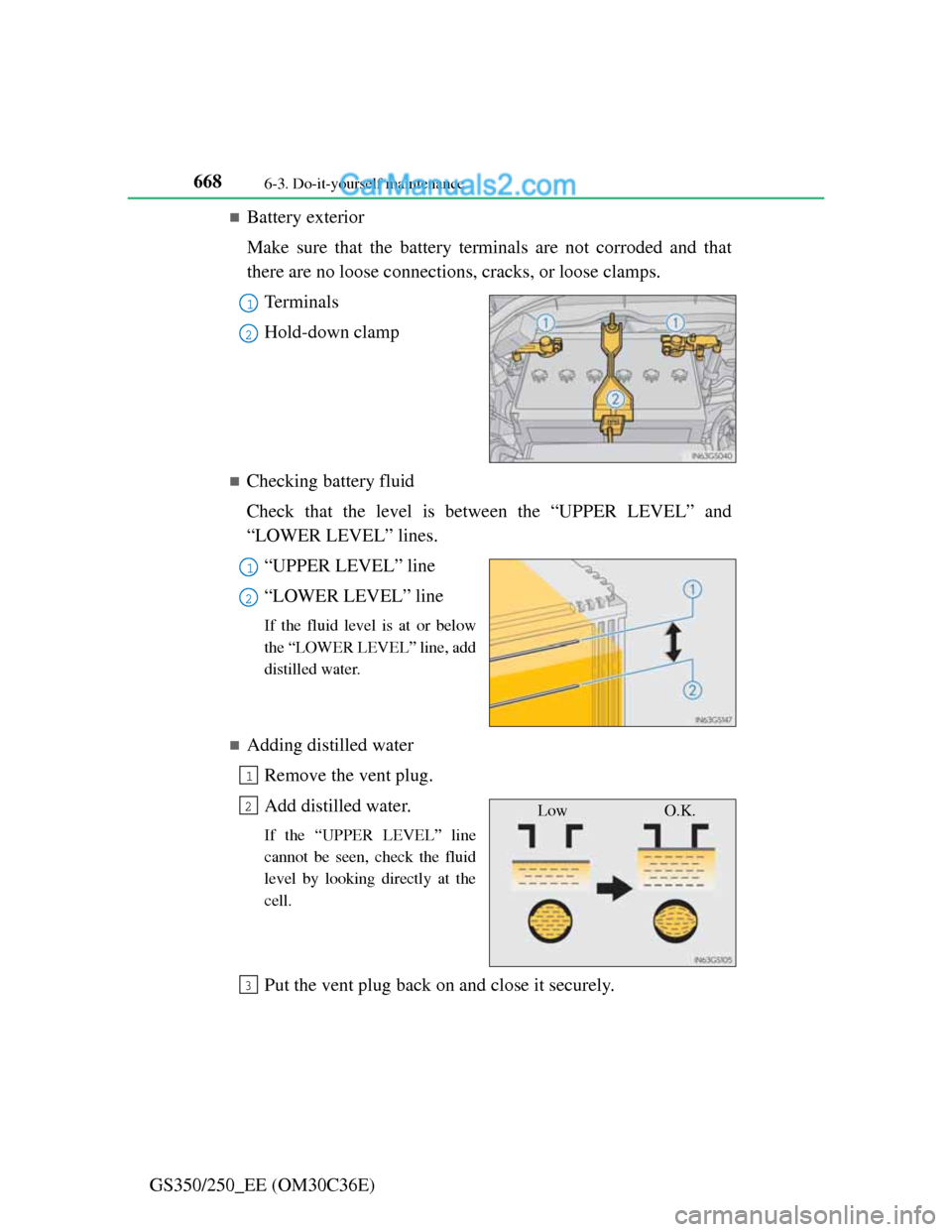
6686-3. Do-it-yourself maintenance
GS350/250_EE (OM30C36E)
Battery exterior
Make sure that the battery terminals are not corroded and that
there are no loose connections, cracks, or loose clamps.
Te r m i n a l s
Hold-down clamp
Checking battery fluid
Check that the level is between the “UPPER LEVEL” and
“LOWER LEVEL” lines.
“UPPER LEVEL” line
“LOWER LEVEL” line
If the fluid level is at or below
the “LOWER LEVEL” line, add
distilled water.
Adding distilled water
Remove the vent plug.
Add distilled water.
If the “UPPER LEVEL” line
cannot be seen, check the fluid
level by looking directly at the
cell.
Put the vent plug back on and close it securely.
1
2
1
2
1
Low O.K.2
3
Page 687 of 914
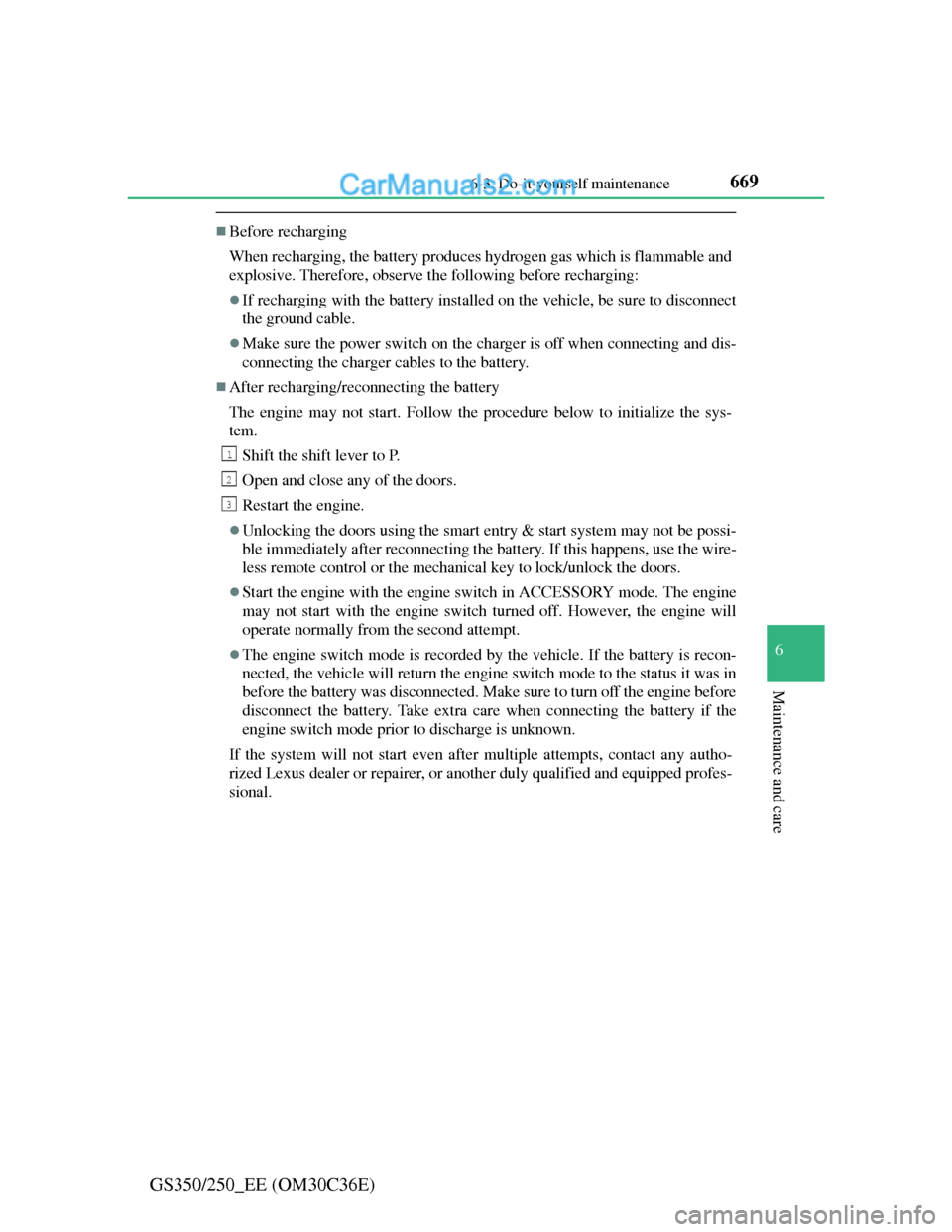
669 6-3. Do-it-yourself maintenance
6
Maintenance and care
GS350/250_EE (OM30C36E)
Before recharging
When recharging, the battery produces hydrogen gas which is flammable and
explosive. Therefore, observe the following before recharging:
If recharging with the battery installed on the vehicle, be sure to disconnect
the ground cable.
Make sure the power switch on the charger is off when connecting and dis-
connecting the charger cables to the battery.
After recharging/reconnecting the battery
The engine may not start. Follow the procedure below to initialize the sys-
tem.
Shift the shift lever to P.
Open and close any of the doors.
Restart the engine.
Unlocking the doors using the smart entry & start system may not be possi-
ble immediately after reconnecting the battery. If this happens, use the wire-
less remote control or the mechanical key to lock/unlock the doors.
Start the engine with the engine switch in ACCESSORY mode. The engine
may not start with the engine switch turned off. However, the engine will
operate normally from the second attempt.
The engine switch mode is recorded by the vehicle. If the battery is recon-
nected, the vehicle will return the engine switch mode to the status it was in
before the battery was disconnected. Make sure to turn off the engine before
disconnect the battery. Take extra care when connecting the battery if the
engine switch mode prior to discharge is unknown.
If the system will not start even after multiple attempts, contact any autho-
rized Lexus dealer or repairer, or another duly qualified and equipped profes-
sional.
1
2
3
Page 688 of 914
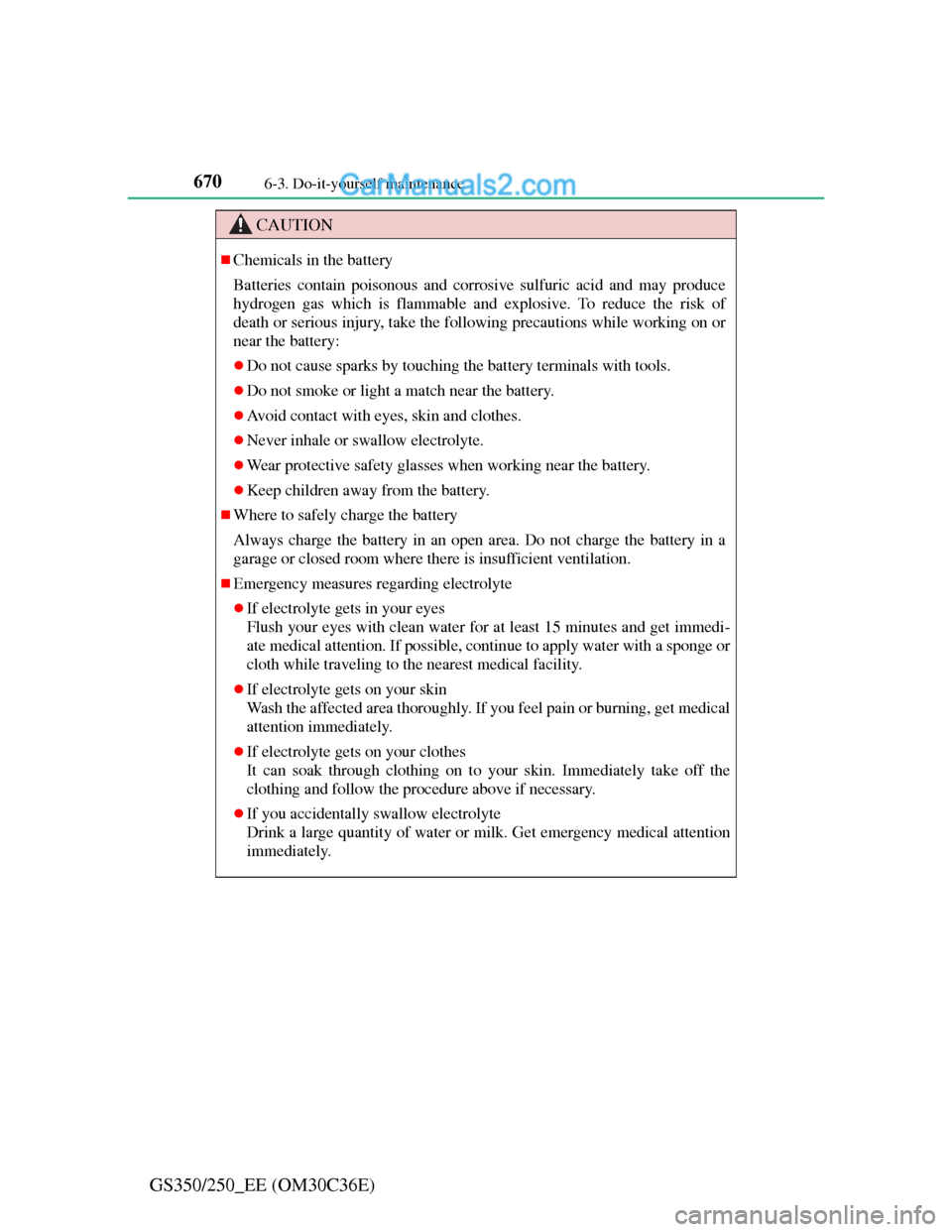
6706-3. Do-it-yourself maintenance
GS350/250_EE (OM30C36E)
CAUTION
Chemicals in the battery
Batteries contain poisonous and corrosive sulfuric acid and may produce
hydrogen gas which is flammable and explosive. To reduce the risk of
death or serious injury, take the following precautions while working on or
near the battery:
Do not cause sparks by touching the battery terminals with tools.
Do not smoke or light a match near the battery.
Avoid contact with eyes, skin and clothes.
Never inhale or swallow electrolyte.
Wear protective safety glasses when working near the battery.
Keep children away from the battery.
Where to safely charge the battery
Always charge the battery in an open area. Do not charge the battery in a
garage or closed room where there is insufficient ventilation.
Emergency measures regarding electrolyte
If electrolyte gets in your eyes
Flush your eyes with clean water for at least 15 minutes and get immedi-
ate medical attention. If possible, continue to apply water with a sponge or
cloth while traveling to the nearest medical facility.
If electrolyte gets on your skin
Wash the affected area thoroughly. If you feel pain or burning, get medical
attention immediately.
If electrolyte gets on your clothes
It can soak through clothing on to your skin. Immediately take off the
clothing and follow the procedure above if necessary.
If you accidentally swallow electrolyte
Drink a large quantity of water or milk. Get emergency medical attention
immediately.
Page 689 of 914
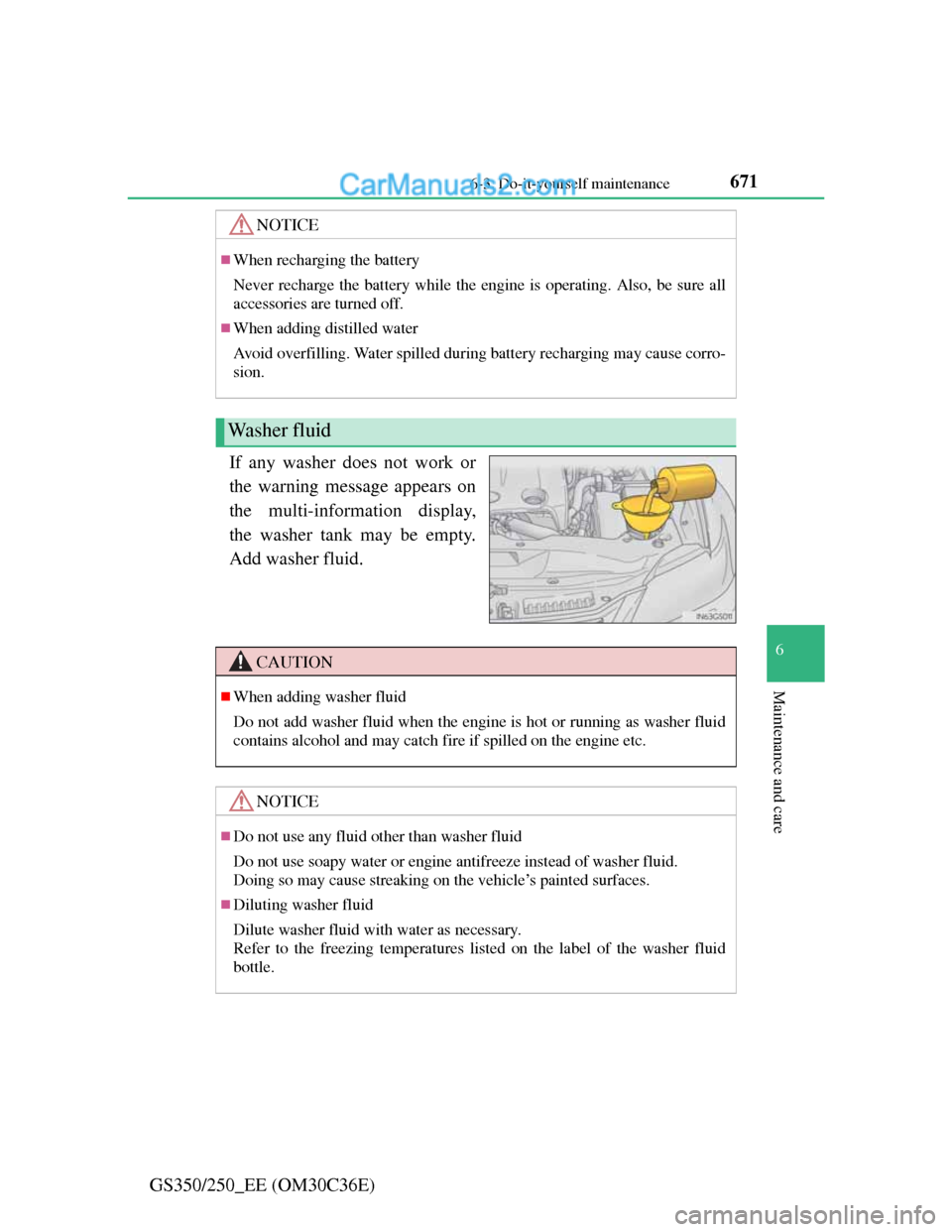
671 6-3. Do-it-yourself maintenance
6
Maintenance and care
GS350/250_EE (OM30C36E)If any washer does not work or
the warning message appears on
the multi-information display,
the washer tank may be empty.
Add washer fluid.
NOTICE
When recharging the battery
Never recharge the battery while the engine is operating. Also, be sure all
accessories are turned off.
When adding distilled water
Avoid overfilling. Water spilled during battery recharging may cause corro-
sion.
Washer fluid
CAUTION
When adding washer fluid
Do not add washer fluid when the engine is hot or running as washer fluid
contains alcohol and may catch fire if spilled on the engine etc.
NOTICE
Do not use any fluid other than washer fluid
Do not use soapy water or engine antifreeze instead of washer fluid.
Doing so may cause streaking on the vehicle’s painted surfaces.
Diluting washer fluid
Dilute washer fluid with water as necessary.
Refer to the freezing temperatures listed on the label of the washer fluid
bottle.
Page 690 of 914
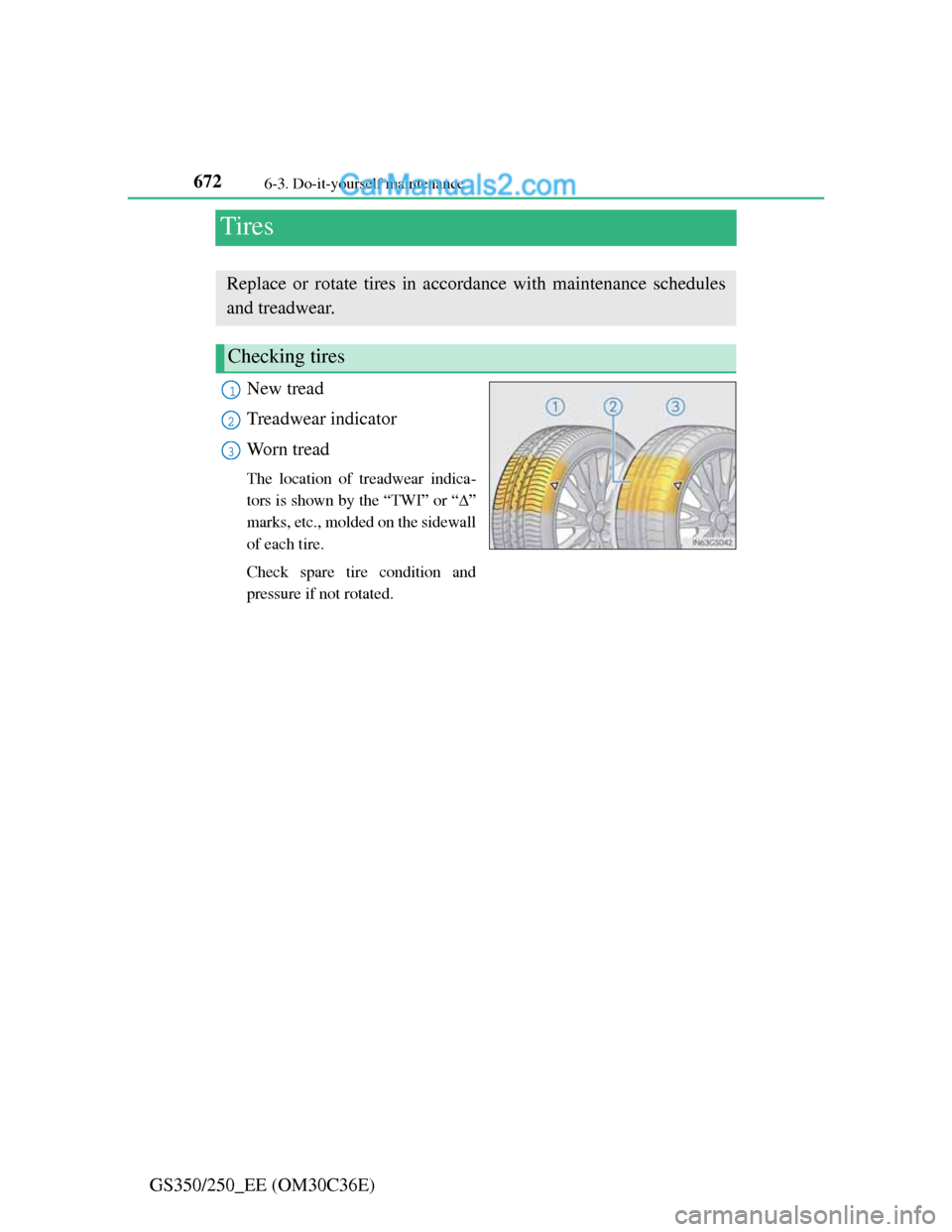
6726-3. Do-it-yourself maintenance
GS350/250_EE (OM30C36E)
Tires
New tread
Treadwear indicator
Worn tread
The location of treadwear indica-
tors is shown by the “TWI” or “”
marks, etc., molded on the sidewall
of each tire.
Check spare tire condition and
pressure if not rotated.
Replace or rotate tires in accordance with maintenance schedules
and treadwear.
Checking tires
1
2
3